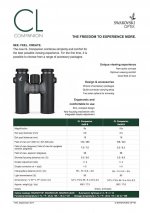Just out of curiosity, what is the difference between the two, Phase-correcting P-coating and SWAROBRIGHT?
From EL series' product page, for example
https://www.bhphotovideo.com/c/product/1176824-REG/swarovski_32208_8x32_el_binocular_with.html
both types of coating are mentioned:
In contrast, CL series doesn't seem to have P-coating and SWAROCLEAN.
Notice that here SWAROBRIGHT is described as "phase-correcting", which really confuses me.
Are these two coatings are the same thing, or P-coating is something else that only exists in EL?
From EL series' product page, for example
https://www.bhphotovideo.com/c/product/1176824-REG/swarovski_32208_8x32_el_binocular_with.html
both types of coating are mentioned:
SWAROBRIGHT coatings provide enhanced contrast, brightness, and color fidelity
SWAROTOP coatings on lenses and prisms reduce light reflection to improve brightness and contrast
Phase-correcting P-coating further improves color and contrast
SWARODUR outer coating on optics helps to prevent scratches and abrasions
SWAROCLEAN non-stick coatings make cleaning dirt, dust, sap, moisture, and fingerprints from lens surfaces easy and fast
In contrast, CL series doesn't seem to have P-coating and SWAROCLEAN.
Swarovski Optical Coatings:
SWAROBRIGHT phase-correcting prism coating eliminates internal interference to improve contrast and resolution
SWAROTOP anti-reflective multi-coating maximizes light transmission, improves contrast and clarity
SWARODUR exterior lens coatings offer scratch-resistance while allowing dirt, dust, oils, and sap to be easily cleaned off without leaving residue to ensure clear and smudge-free views
Notice that here SWAROBRIGHT is described as "phase-correcting", which really confuses me.
Are these two coatings are the same thing, or P-coating is something else that only exists in EL?






